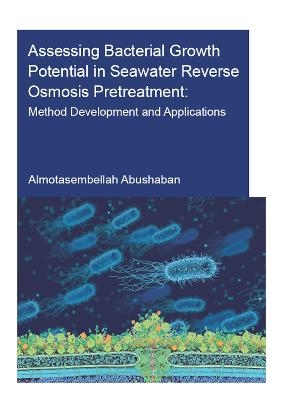
Assessing Bacterial Growth Potential in Seawater Reverse Osmosis Pretreatment
CRC Press (Verlag)
978-0-367-89906-6 (ISBN)
Seawater desalination is increasingly being used as a means to augment freshwater supplies in regions with high water stress, and reverse osmosis is increasingly the technology of choice because of the low energy consumption. However, seawater reverse osmosis (SWRO) systems suffer from various types of fouling, which can increase energy consumption and the use of chemicals during SWRO operation. In practice, pre-treatment systems are put in place to reduce the particulate and biological fouling potential of SWRO feed water. However, simple, reliable and accurate methods to assess the extent to which biological fouling potential is reduced during pre-treatment are not available for seawater.
This research developed a new method to measure bacterial growth potential (BGP) using the native bacterial consortium in seawater. New reagents to extract and detect ATP in microbial cells were specifically developed for seawater. The new lysis and detection reagents overcame the salt interference in seawater and allow low detection of total ATP, free ATP and microbial ATP in seawater. Incorporating a filtration step further increased the sensitivity of the method six fold, enabling ATP detection of ultra-low levels of microbial ATP in seawater.
The newly developed ATP-based BGP method was applied to monitor and assess the pre-treatment of five full-scale seawater desalination plants around the world. A good correlation was observed between BGP measured in SWRO feed water and the pressure drop increase in the SWRO systems, suggesting the applicability of using the ATP-based BGP method as a biofouling indicator in SWRO. Furthermore, a safe level of BGP (<70 µg/L) is proposed for SWRO feed water in order to ensure a chemical cleaning frequency of once/year or lower. However, to validate this conclusion, more SWRO plants with different pre-treatment systems need to be monitored.
In the future, on-line monitoring of BGP in SWRO feed water may further reduce the consumption of chemicals and energy and improve the overall sustainability of seawater desalination by reverse osmosis.
Abushaban completed his MSc in Municipal water and infrastructure at UNSECO-IHE, Netherlands. He is currently finalizing his PhD at Delft University of Technology, in which his research focused on development of methods to control biofouling and scaling of reverse osmosis (RO) and ultrafiltration membrane systems. His work included bench-scale, pilot-scale and even full-scale plants. Abushaban has extensive experience in assessing and troubleshooting the pre-treatment and membrane filtration performance of full-scale seawater/industrial treatment plants. Abushaban was awarded the innovation prize of the international desalination association (IDA) in 2017. Furthermore, Abushaban has worked as water and wastewater consultant engineer, in which he managed designing and rehabilitation of several water supply and sanitation projects in Palestine.
1 General introduction, 2 Direct measurement of ATP in seawater and application of ATP to monitor bacterial growth potential in SWRO pre-treatment systems, 3 ATP measurement in seawater reverse osmosis systems: elimination seawater matrix effects using a filtration-based method, 4 Assessing pretreatment and seawater reverse osmosis performance using an ATP-based bacterial growth potential method, 5 Correlating bacterial growth potential measurement to fouling development in full-scale SWRO, 6 Fouling removal in seawater media filtration used as pre-treatment of a full scale SWRO desalination plant, 7 General conclusions and future perspective.
| Erscheinungsdatum | 23.12.2019 |
|---|---|
| Reihe/Serie | IHE Delft PhD Thesis Series |
| Verlagsort | London |
| Sprache | englisch |
| Maße | 170 x 240 mm |
| Gewicht | 381 g |
| Themenwelt | Naturwissenschaften ► Geowissenschaften ► Geologie |
| Naturwissenschaften ► Geowissenschaften ► Hydrologie / Ozeanografie | |
| Technik ► Bauwesen | |
| Technik ► Umwelttechnik / Biotechnologie | |
| ISBN-10 | 0-367-89906-X / 036789906X |
| ISBN-13 | 978-0-367-89906-6 / 9780367899066 |
| Zustand | Neuware |
| Haben Sie eine Frage zum Produkt? |
aus dem Bereich


